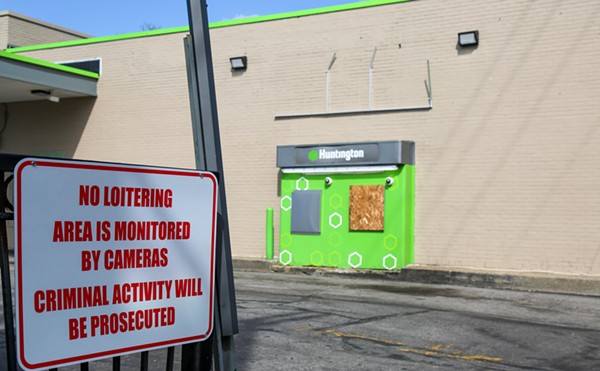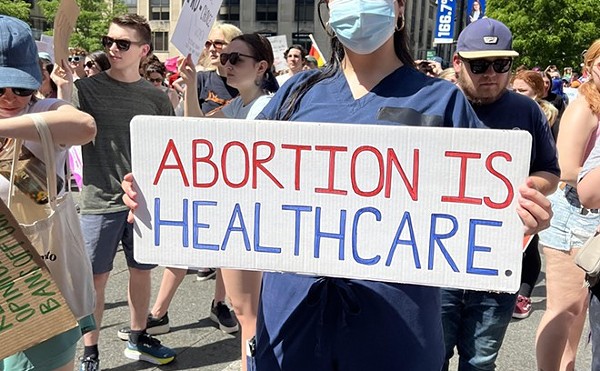RTA Revamps Network to Increase Frequency on Popular Routes. The Interactive Map is Dope.
By Sam Allard on Wed, May 12, 2021 at 2:21 pm
[
{
"name": "Ad - NativeInline - Injected",
"component": "38482495",
"insertPoint": "3",
"requiredCountToDisplay": "5"
},{
"name": "Real 1 Player (r2) - Inline",
"component": "38482494",
"insertPoint": "2/3",
"requiredCountToDisplay": "9"
}
]
When RTA launches its system redesign next month, twice as many people in Cuyahoga County will live within one half mile of a high-frequency transit route, (i.e. a bus or train that arrives every 15 minutes or better). More than 50,000 additional jobs will also be accessible via these high-frequency routes.
The redesigned network, dubbed "Next Gen RTA," is the result of a planning process that began in late 2018 with the assistance of transit consultant Jarrett Walker. Riders and community members were asked to contribute feedback through online surveys and public meetings. Walker's method asked riders to help design an improved system that prioritized either greater frequency or greater coverage. The idea was that with finite resources, a transit agency like RTA can't afford to do both. It can cover a wider geographical area with lower frequency routes, or a more limited area with higher frequency routes.
Naturally, riders wanted both. The feedback demonstrated that riders were interested in "a balanced map," but favored higher frequency slightly, especially when other routes were nearby.
"So what we've done is concentrated service on the streets that have more riders," said RTA's Director of Service Management, Joel Freilich. "We're pumping resources from streets with fewer riders, but never emptying a community of transit."
Respondents said that traveling to work, school and medical care were their most important trips they took via transit, and Freilich said that routes were enhanced with those priorities in mind.
In some cases, routes were lengthened and/or reconfigured to travel to job and retail hubs. Two Next Gen routes — the new #25 and the #18 — both now service Steelyard Commons, for example, a job and retail center that had been largely isolated from the existing transit network, serviced infrequently by the #81 through Tremont.
In other cases, popular routes that already went to major job centers and other key destinations were enhanced with higher frequency. Both the #22 on Lorain Avenue on the West side and the #10 on E. 105th Street on the East Side will both arrive every 15 minutes or better on weekdays through the evening rush hour.
"The chief benefit is time," said Freilich. "In order to accomplish these objectives — to attend that class, to get that medical care, to work that job — riders need to ask themselves, 'How early do I need to leave home? How long will it take me to get back?' The main determinant of how quickly you'll be home is not whether, when you get to your home neighborhood, you walk five minutes or 10. It's the bus outside that grocery store, that medical facility or that job. How frequently is it running? Next Gen RTA offers a significant improvement."
Cuts had to be made in order to accommodate this higher frequency service. In addition to stops on certain existing routes being eliminated, a few Park-n-Ride direct buses from the suburbs have been cut, along with most of the free trolley circulators downtown. A modified "B-Line" trolley, with service along the rectangle demarcated by W. 9th, Superior, E. 12th and Lakeside, will be the only trolley moving forward.
Chris Stocking, of the grassroots transit advocacy group Clevelanders for Public Transit, said most members of CPT were pleased with the way the redesigned map turned out.
"We think the redistribution of resources to high-frequency neighborhood bus routes is a pretty good net benefit," he said.
CPT would have liked to have seen a bit more outreach to riders on buses and at bus stops — meeting riders where they are — but Stocking said that Jarrett Walker's process was a crucial step in improving the local transit map after years of cuts.
"What we'd like to be talking about is an expanded funding concept," Stocking said. "RTA could increase the number of people who live near a high-frequency route by 250%, but that's gonna take a lot more funding. And it wouldn't have made sense to pour new money into the existing network, after years and years of cutting ends off routes. The redesign isn't perfect — there have to be tradeoffs — but there's going to be more frequent service for more people, and that's good."
To promote the launch of Next Gen RTA, all transit travel will be free during the first week of operation, from June 13 through June 19. You can explore the new routes at the Next Gen site's interactive map.
***
Sign up for Scene's weekly newsletters to get the latest on Cleveland news, things to do and places to eat delivered right to your inbox.
The redesigned network, dubbed "Next Gen RTA," is the result of a planning process that began in late 2018 with the assistance of transit consultant Jarrett Walker. Riders and community members were asked to contribute feedback through online surveys and public meetings. Walker's method asked riders to help design an improved system that prioritized either greater frequency or greater coverage. The idea was that with finite resources, a transit agency like RTA can't afford to do both. It can cover a wider geographical area with lower frequency routes, or a more limited area with higher frequency routes.
Naturally, riders wanted both. The feedback demonstrated that riders were interested in "a balanced map," but favored higher frequency slightly, especially when other routes were nearby.
"So what we've done is concentrated service on the streets that have more riders," said RTA's Director of Service Management, Joel Freilich. "We're pumping resources from streets with fewer riders, but never emptying a community of transit."
Respondents said that traveling to work, school and medical care were their most important trips they took via transit, and Freilich said that routes were enhanced with those priorities in mind.
In some cases, routes were lengthened and/or reconfigured to travel to job and retail hubs. Two Next Gen routes — the new #25 and the #18 — both now service Steelyard Commons, for example, a job and retail center that had been largely isolated from the existing transit network, serviced infrequently by the #81 through Tremont.
In other cases, popular routes that already went to major job centers and other key destinations were enhanced with higher frequency. Both the #22 on Lorain Avenue on the West side and the #10 on E. 105th Street on the East Side will both arrive every 15 minutes or better on weekdays through the evening rush hour.
"The chief benefit is time," said Freilich. "In order to accomplish these objectives — to attend that class, to get that medical care, to work that job — riders need to ask themselves, 'How early do I need to leave home? How long will it take me to get back?' The main determinant of how quickly you'll be home is not whether, when you get to your home neighborhood, you walk five minutes or 10. It's the bus outside that grocery store, that medical facility or that job. How frequently is it running? Next Gen RTA offers a significant improvement."
Cuts had to be made in order to accommodate this higher frequency service. In addition to stops on certain existing routes being eliminated, a few Park-n-Ride direct buses from the suburbs have been cut, along with most of the free trolley circulators downtown. A modified "B-Line" trolley, with service along the rectangle demarcated by W. 9th, Superior, E. 12th and Lakeside, will be the only trolley moving forward.
Chris Stocking, of the grassroots transit advocacy group Clevelanders for Public Transit, said most members of CPT were pleased with the way the redesigned map turned out.
"We think the redistribution of resources to high-frequency neighborhood bus routes is a pretty good net benefit," he said.
CPT would have liked to have seen a bit more outreach to riders on buses and at bus stops — meeting riders where they are — but Stocking said that Jarrett Walker's process was a crucial step in improving the local transit map after years of cuts.
"What we'd like to be talking about is an expanded funding concept," Stocking said. "RTA could increase the number of people who live near a high-frequency route by 250%, but that's gonna take a lot more funding. And it wouldn't have made sense to pour new money into the existing network, after years and years of cutting ends off routes. The redesign isn't perfect — there have to be tradeoffs — but there's going to be more frequent service for more people, and that's good."
To promote the launch of Next Gen RTA, all transit travel will be free during the first week of operation, from June 13 through June 19. You can explore the new routes at the Next Gen site's interactive map.
***
Sign up for Scene's weekly newsletters to get the latest on Cleveland news, things to do and places to eat delivered right to your inbox.
Tags:
SCENE Supporters make it possible to tell the Cleveland stories you won’t find elsewhere.
Become a supporter today.
About The Author
Sam Allard
Sam Allard is the Senior Writer at Scene, in which capacity he covers politics and power and writes about movies when time permits. He's a graduate of the Medill School of Journalism at Northwestern University and the NEOMFA at Cleveland State. Prior to joining Scene, he was encamped in Sarajevo, Bosnia, on an...
Scroll to read more Cleveland News articles
Newsletters
Join Cleveland Scene Newsletters
Subscribe now to get the latest news delivered right to your inbox.















